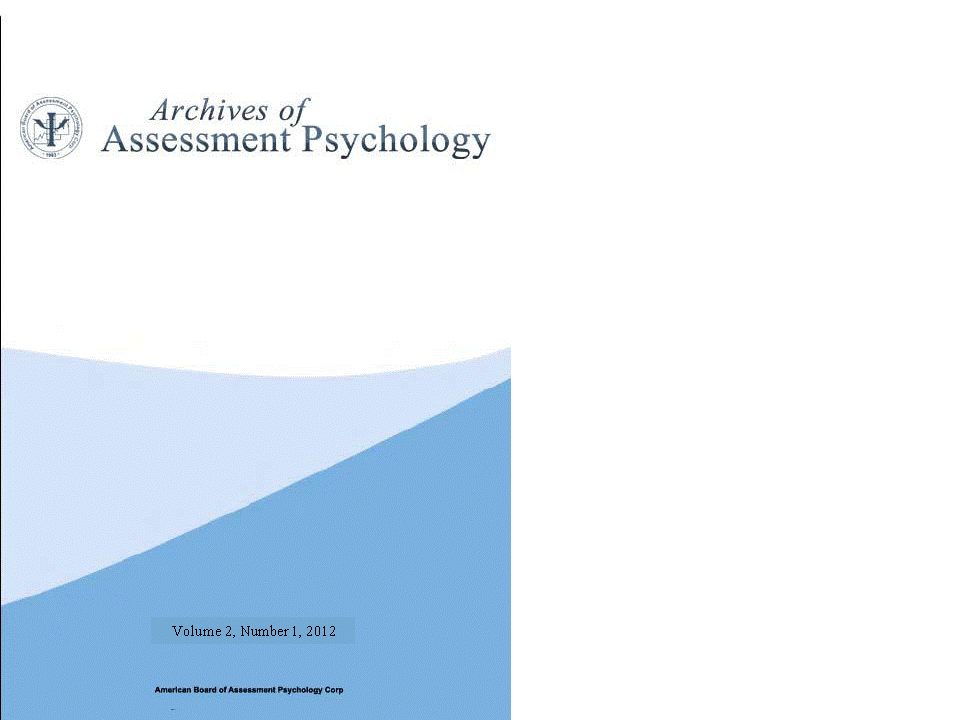Decomposition of the Trail Making Test - Reliability and Validity of a Computer Assisted Method for Data Collection
Abstract
The present study describes the use of computer assisted software to decompose the Trail Making Test. The study shows that this methodology is reliable and produces data comparable to those which are produced using pencil and paper forms. Additionally, it confirms that particular sections of the Trail Making Test provide incremental validity for the assessment of executive functions as measured by the Verbal Fluency and Five Point Tests. The present study suggests that the adaptation of computer assisted testing to clinical practice is an important evolutionary step as it provides clinicians with higher resolution for traditional measures and discerns the multiple cognitive operations within them, allowing for the identification of nonspecific error variance that impacts test performance.References
Ashendorf, L., Jefferson, A. L., O'Connor, M. K., Chaisson, C., Green, R. C., & Stern, R. A. (2008). Trail Making Test errors in normal aging, mild cognitive impairment, and dementia. Archives of Clinical Neuropsychology, 23, 129-137.
Benton, A., & de Hamsher, K. S. (1976). Multilingual aphasia examination. Iowa City:
University of Iowa.
Drane, D. L., Yuspeh, R. L., Huthwaite, J. S., & Klingler, L. K. (2002). Demographic characteristics and normative observations for derived-trail making test indices. Neuropsychiatry, Neuropsychology and Behavioral Neurology, 15(1), 39-43.
Epker, M. O., Lacritz, L. H., & Cullum, C. M. (1999). Comparative analysis of qualitative verbal fluency performance in normal elderly and demented populations. Journal of Clinical and Experimental Neuropsychology, 21, 425-34.
Kaplan, E. (1983). A process approach to neuropsychological assessment. In T. Boll & B. K. Bryant (Eds.) Clinical neuropsychology and brain function: Research, measurement, and practice (pp. 125-167). Washington D.C.: American Psychological Press.
Kaplan, E. (1990). The process approach to neuropsychological assessment of psychiatric patients. Journal of Neuropsychiatry and Brain Functions: Research Measurement, and Practice, 2, 72-87.
Lezak, M., Howieson D.B., & Loring D.W. (2004). Neuropsychological assessment 4th Edition. New York: Oxford University Press.
Luria, A. R. (1963). Restoration of function after brain injury. Oxford, England: Pergamon Press.
Luria, A. R. (1973). The man with a shattered world: The history of a brain wound. Cambridge, MA: Harvard University Press.
Martin, T. A., Hoffman, N. M., & Donders, J. (2003). Clinical utility of the Trail Making Test ratio score. Applied Neuropsychology, 10 (3), 163 – 169.
Meyers, J. E., & Meyers, K. R. (1995). Rey Complex Figure and recognition trial. Odessa, FL: Psychological Assessment Resources.
Miller, A. (2010). Examining the Errors and Self-Corrections on the Stroop Test. (Master’s Thesis). Cleveland State University, Cleveland, OH.
Mitrushina, M., Boone, K. B., Rzani, J., & D’Elia, L. F. (2005). Handbook of normative data for neuropsychological assessment (2nd Edition). City?: Oxford University Press.
Pick, A. & Thiele, R. (1931). Aphasie. In A. Bethe (ed.), Handb. d. Norm. u. Pathol. Physiol. Vol. XV, 2. Berlin: Springer.
Poreh, A. (2000). The quantified process approach: An emerging methodology to neuropsychological assessment. The Clinical Neuropsychologist, 14 (2), 212 – 222.
Poreh, A. (2006). Introduction to the Quantified Process Approach. In A. Poreh (Ed.),The Quantified Process Approach to neuropsychological assessment (pp. 3-15). New York: Taylor & Francis Group, Psychological Press.
Regard, M. (1982). Children’s production of verbal and nonverbal fluency tasks. Perceptual and Motor Skills, 55, 839-844.
Regard, M. (1991). The perception and control of emotions: Hemispheric differences and the role of the frontal lobes (Habilitationsschrift (Post Doctoral Thesis)). University Hospital, Department of Neurology, Zurich, Switzerland.
Reitan, R. M. (1958). Validity of the Trail Making Test as an indication of organic brain damage. Perceptual and Motor Skills, 8, 271-276.
Rich, J. B., Troyer, A. K., Bylsma, F. W., & Brandt, J. (1999). Longitudinal analysis of phonemic clustering and switching during word-list generation in Huntington’s disease. Neuropsychology, 13, 525-531.
Salo, R., Henik, A., & Robertson, L. C. (2001). Interpreting Stroop interference: An analysis of differences between task versions. Neuropsychology, 15, 462-71.
Schulenberg, S. E., & Yutrzenkab, B. A. (2004). Ethical issues in the use of computerized assessment. Computers in Human Behavior, 20, 477–490.
Steinberg, B. A. Bieliauskas, L. A., Smith, G. E., & Ivnik, R. J. (2005). Mayo's Older Americans Normative Studies: Age- and IQ-Adjusted Norms for the Trail-Making Test, the Stroop Test, and MAE Controlled Oral Word Association Test. Clinical Neuropsychologist, 19, 329-377.
Strauss, E., Sherman, E. M. S., & Spreen, O. (2006). A compendium of neuropsychological tests – Administration, norms and commentary (3rd Edition). Oxford: Oxford University Press.
Tombaugh, T. N. (2004). Trail Making Test A and B: Normative data stratified by age and education. Archives of Clinical Neuropsychology, 19(2), 203-14.
Troster, A. I., Fields, J. A., Testa, J. A., Paul, R. H., Blanco, C. R., Hames, K. A., et al. (1998). Cortical and subcortical influences on clustering and switching in the performance of verbal fluency tasks. Neuropsychologia, 36, 295-304.
Troyer, A. K., Moscovitch, M., & Winocur, G. (1997). Clustering and switching as two components of verbal fluency: Evidence from younger and older healthy adults. Neuropsychology, 11, 138-146.
Troyer, A. K., Moscovitch, M., Winocur, G., Alexander, M. P., & Stuss, D. (1998). Clustering and switching on verbal fluency: the effects of focal frontal- and temporal-lobe lesions. Neuropsychologia, 36, 499-504.
Yocum, A. (2008). Employing strategy in measures of executive functioning: Young vs. old adults (Master’s Thesis). Cleveland State University, Cleveland, OH.
Werner, H. (1956). Microgenesis and aphasia. The Journal of Abnormal and Social Psychology, 52, 347-353.
Woodard, J. L., Dunlosky, J. A., & Salthouse, T. A. (1999). Task decomposition analysis of the inter trial free recall performance on the Rey Auditory Verbal Learning Test in normal aging and Alzheimer’s disease. Journal of Clinical and Experimental Neuropsychology, 21, 666-676.

